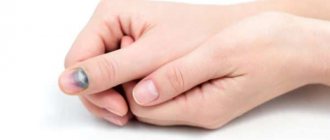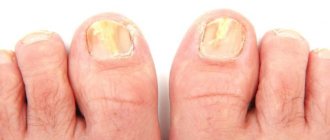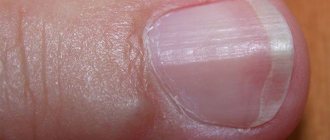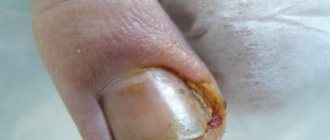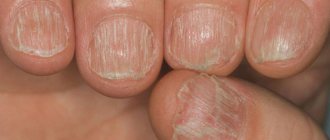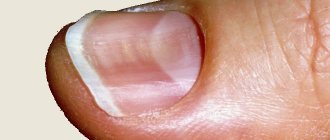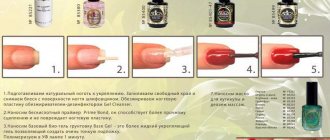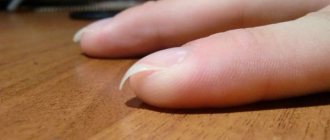Causes of blue nails
Blue fingernails (the cause can only be identified after undergoing a full examination by a specialist) can signal the presence of the following pathologies:
| Causes | Among women | In men | In children |
| Injury. As a result, the vessels are damaged, blood accumulates under the nail plate forming a hematoma. | Hitting or pinching the finger when doing household chores predominates. | Bruises or pinched fingers are more often associated with professional activities. | Occurs mainly during games. |
| Exposure to low temperatures. A narrowing of the capillaries occurs, as a result, the nutrition of the tissues under the nail plates deteriorates, which is accompanied by a temporary blue discoloration of the nail. | Occurs when gloves or mittens are ignored in the cold, during prolonged contact with a cold object, or when hands are placed in cold water. | ||
| Complication after a manicure. | The use of low-quality nail care materials, carelessness in the procedures carried out by the master. | Occurs when the nails are cut carelessly and damage the cuticle or plate. | |
| The body's negative reaction is not a chemical compound. | Contact with aggressive detergents, powder or cleaning agents. | Contact with chemical compounds during professional activities. | Using expired or inappropriate hand care products. |
| Taking medications. Some types of medications can cause disruption of the capillaries under the nail plates. Or, as a result of a chemical reaction, cause the nail to turn blue. | Depends on the individual characteristics of the body. | ||
| Violation of the condition of blood vessels and blood circulation. Fragile capillaries bleed at the slightest pressure on the plate. | It can develop due to a lack of vitamins or during pregnancy. | Occurs with poor diet and excess weight. | It can be observed during adolescence with increased growth of a teenager. |
| Liver dysfunction. Intoxication of the body develops, which can cause blue nails. | More often observed during pregnancy due to increased load on the organ | Poor nutrition, alcohol abuse. | Consequences of taking medications. |
| Heart dysfunction. As a result, insufficient nutrients reach the tissues under the nail plates. | During pregnancy or if you are overweight, the load on the organ increases. | Excess weight or abuse of alcohol and nicotine. | Transitional age, when during the period of active growth tissues require more nutrients. And also due to the presence of intrauterine abnormalities. |
| Hormonal imbalance or metabolic disorder in tissues. | During pregnancy or menopause. | Disruption of the functioning of the endocrine system. | In adolescence. |
| Fungal infections. Due to the activity of the pathogen, the nail plate may change color from yellow to dark blue. | Failure to comply with hygiene measures when visiting crowded places. | ||
| Impaired functioning of the pulmonary system. Due to lack of oxygen, not only the nails, but also the nasolabial triangle may turn blue. | It is noted in the presence of excess weight or pathologies in the respiratory system (asthma, colds, bronchitis). | ||
| Raynaud's disease | Manifested by impaired blood supply to the extremities. Most often develops between the ages of 16 and 25 years. | ||
| Melanoma. | Skin cancer is manifested by darkening of the epidermis. May be located under the nail plate. | ||
| Wilson's disease | The pathology is manifested by a violation of copper metabolism in the body, which leads to blue nails. | ||
| Diabetes. The disease is accompanied by disturbances in blood composition and vascular condition. | It can develop independently or be inherited. | ||
If blue nails are not associated with external influences (trauma, use of chemicals or cold), then consultation with a therapist/pediatrician followed by examination is necessary.
What to do for prevention?
The following recommendations will help you avoid nail problems:
- work with gloves in case of inevitable contact with chemical reagents - detergents and cleaners;
- purchase quality cosmetics;
- do not use other people’s gloves and clothing to prevent fungal diseases of the hands;
- try not to injure your fingers;
- carefully carry out manicures and pedicures, work only with personal tools or regularly process them;
- in cold weather, wear gloves or mittens;
- for systemic diseases - follow the doctor’s instructions and fulfill all instructions;
- Take care of your overall health and undergo regular medical examinations.
It is necessary to monitor the condition of the nail plate not only from an aesthetic point of view. The body always reacts to pathological changes as much as possible. If the nail plate has changed color, began to crumble and peel, you should think about your health and lifestyle. You should not self-medicate and let things take their course.
Symptoms of pathologies
Blue fingernails (the cause can be identified by the presence of additional symptoms) may signal the development of hidden diseases. Based on the signs described below, you can independently determine the reason for the change in color of the plate.
Trauma or pinch
Blue discoloration of the nail is observed one day after the injury. The finger may swell, swell, and be painful to the touch. The blueness may go away on its own (if there is no fracture) from 7 to 30 days.
Exposure to low temperatures
With a long stay in the cold, water procedures in cool water, not only the nail may turn blue, but also a temporary loss of sensitivity. If frostbite does not occur, then the color of the nail plate and sensitivity are restored within 1 hour after staying warm.
Complication from manicure
If nails are trimmed incorrectly, blue discoloration appears within 24 hours along with redness and swelling of the soft tissues. The sensation of soreness may be mild or severe. Color normalization is possible within 14 days.
If blue discoloration is observed due to exposure to acetone, varnish or care products. This color change may appear immediately or within 3 days. Additional symptoms may include swelling, redness of the skin and itching. It is necessary to immediately remove the cosmetic product, after which the blue discoloration will disappear within 10 days.
Negative reaction to chemicals
Blueness of the nail as a result of prolonged contact with chemical compounds may be accompanied by an allergic reaction or occur without symptoms (only a change in the color of the plate). After eliminating the cause, the color of the nail is restored in 3-7 days.
Taking medications
Along with turning blue, a change in skin color is possible, as well as a general deterioration in health. If this side effect is not specified in the instructions for the drug, then it is necessary to consult your doctor about continuing treatment. The color of the nail will be restored within 14 days after stopping the medication.
Vascular and circulatory disorders
Hemorrhage is possible not only under the nail plates. Small hematomas may be present throughout the body. Due to lack of blood circulation, you will feel constant fatigue and drowsiness.
Restoring the color under the nails is possible only after restoring the condition of the blood vessels and blood circulation.
Deterioration of liver function
Blueness of the nail plates may be accompanied by yellowing of the skin or whites of the eyes, as well as a pain symptom in the right hypochondrium. The color under the nails will restore on its own once the root cause is eliminated.
Cardiac dysfunction
With heart pathologies, severe fatigue, chest pain, and pale skin are noted. A striking symptom is a bluish discoloration of the area near the nasolabial triangle and the lips themselves. In this case, emergency medical care is required.
Hormonal imbalance or metabolic disorder
Blueness due to hormonal or metabolic imbalance may be accompanied by changes in weight, mood swings, unstable menstruation or its absence (in women). To restore the color of the nail plates, drug treatment is required.
Nail fungus
With a fungal infection, along with a change in color, there is a disturbance in the texture of the nail (crumbs, unevenness appears), the appearance of severe itching and peeling of the skin. The appearance of cracks between the fingers and the presence of an unpleasant, pronounced odor are also noted. In some cases, the nail may begin to pull away from the skin. The use of antifungal drugs is required.
Pulmonary pathologies
A change in the color of the nail is accompanied by breathing problems (possibly the development of suffocation), cyanosis of the skin and severe weakness. With infectious diseases, a severe cough may be present. Treatment is prescribed by a doctor.
Raynaud's disease
It is accompanied by blue discoloration of not only the nail plates, but also the fingers themselves, sensitivity decreases and pressure increases. When rubbing the extremities, redness of the tissues and a gradual return of the natural color to the fingers and nail plates are possible.
Blue fingernails, numbness - the cause is Raynaud's syndrome
Urgent confirmation of the pathology and drug treatment are necessary.
Wilson's disease
The disease can occur in several forms, depending on which organ is affected by excess copper in the body. Along with blueness of the nail plates, yellowing of the epidermis, hand tremors, and a disturbance in the psychological state are possible. Diagnosis followed by treatment is necessary.
Melanoma
The disease is manifested by the appearance of a blue longitudinal stripe on the nail (the entire plate will gradually turn blue), followed by the release of pus and possible separation of the nail plate from the skin. The sooner the pathology is diagnosed, the greater the success for a complete recovery.
If the blueness of the nail persists for a long time without external influences, there is a pronounced pain symptom and there is a deterioration in general health, it is recommended to immediately consult a specialist.
Diabetes
In diabetes, blue discoloration is observed only at the base of the nail. With a sharp increase in blood sugar levels, your fingers may turn blue. Additionally, it is accompanied by severe thirst, increased urination, and there may be notes of acetone on breath.
Examination and medication are required.
Diagnostics
The reason for the change in the color of the nail plate on the hands cannot always be determined independently. To confirm the diagnosis and prescribe treatment, an examination is required. To more accurately establish the pathology, it is necessary to know exactly how long ago the blue discoloration appeared on the nails.
To diagnose the disease, a specialist prescribes the following procedures:
- Visual inspection and collection of information:
- chronic diseases are identified;
- it is specified when the blueness of the nail occurred;
- the presence of additional symptoms is determined;
- predisposition to diabetes and cancer is clarified;
- The condition of the nail plate is assessed.
- Taking urine and blood tests. Based on the data obtained, the general condition of the patient is determined, diabetes and the presence of infection in the body are excluded or confirmed.
- Taking a scraping from the nail plate. It is necessary when a fungal infection is suspected to determine the type of pathogen.
- Biopsy to rule out/confirm the presence of cancer cells.
- Wood's lamp glow. It also helps identify fungal infections.
- ECG to detect cardiac dysfunction.
- X-ray to detect pathologies in the lungs.
If there is insufficient data from the above examinations, an MRI may be prescribed.
Treatment for blue nails
Blue fingernails (the cause can be accurately diagnosed only after undergoing an examination) are not only a cosmetic defect, so drug treatment is required, which is selected by a doctor.
Medicines
The choice of medications is made depending on the cause of the blueness of the nail plate.
| Cause of blue nails | Name of the drug and release form | Drug group | Rules of application |
| Injury | Ketanov, tablets. | Painkiller | Take 1 tablet no more than 4 times a day, no longer than 5 days. |
| Venitan, gel. | Eliminates swelling and inflammation, accelerates hematoma resorption | Use 2-3 times a day until the hematoma is eliminated. | |
| Dimexide, gels and solution. | Analgesic and anti-inflammatory | Dilute the solution with water in a ratio of 1:3 and use it as a compress 1-3 times a day. Leave for 30 minutes. Apply the gel 1-3 times a day. Treatment is carried out no longer than 10 days. | |
| Taking medications | Activated carbon, tablets, | Sorbent | Used to completely remove the drug from the body. Take at the rate of 1 tablet per 10 kg of weight no more than 3 times a day, no longer than 5 days. |
| Suprastin, tablets. | Antihistamine | To relieve inflammation and allergic reactions. Take 1 tablet 1-2 times a day for no more than 3 days. | |
| Vascular and circulatory disorders | Ascorutin, tablets. | Restore the condition of blood vessels | Take 1 tablet 2-3 times a day for 15-30 days. |
| Troxevasin, capsules and gel. | Take 1-2 tablets 3 times a day for 3-4 weeks. | ||
| Chimes, tablets. | Restore blood circulation | Take 1 tablet 3 times a day for 10-14 days. | |
| Liver diseases | Pancreatin, tablets. | The drug contains enzymes to normalize liver activity | Take 1-2 tablets 2-3 times a day for 14-30 days. |
| Phosphogliv, capsules. | Restores liver tissue | Take 1-2 capsules 3-4 times for up to 3 months. | |
| Polysorb, powder. | Accelerates the elimination of toxins, facilitating liver function | Dosage depends on weight (0.2 g per 1 kg), take for 5 days. | |
| Heart dysfunction | Aspirin cardio, tablets. | Painkillers, blood thinners and anti-inflammatory | Take 1 tablet every other day. The duration of treatment is prescribed by the doctor. |
| Enalapril tablets. | Lower blood pressure and dilate blood vessels. | Take 1 tablet 1 time per day. The course is selected individually. | |
| Pathologies of the pulmonary system | Teopek, tablets. | Normalize the activity of the pulmonary system | Take 400 mg of the drug per day for 3 days. |
| Pulmicort, solution for inhalation. | Hormonal agent for normalizing breathing | The dosage and course are prescribed by the doctor depending on the severity of the pathology. | |
| Hormonal disbalance | Duphaston tablets. | Contain progesterone | Take 1 tablet. from 5 to 25 days of menstruation for 3-6 months. |
| Regulon, tablets. | Normalize hormonal levels | Take 1 tablet from the 1st to the 25th day of menstruation for 3 months. | |
| Fungal infection | Lamisil, spray and ointment. | Antifungal | Use 1-2 times a day for 7 days. |
| Mikozan, serum. | Use 1-2 times a day for 3-5 weeks. | ||
| Diabetes | Metformin, tablets. | Normalizes glucose levels in the body | Dosage and course are prescribed individually. |
| Glucophage, tablets. | |||
| Raynaud's disease | Trental, tablets. | Dilate blood vessels and normalize blood circulation | Take 1 tablet 3 times a day. The course is assigned individually. |
| Pentoxifylline tablets. | Take 2 tablets 2 times a day. The duration of treatment is determined by the doctor. | ||
| Wilson's disease | Cuprenil, tablets. | Helps remove copper from the body | The dosage is selected individually. It is necessary to take tablets 4 times a day for 2 months. |
The exact course and dosage of drugs are selected individually based on the general condition of the patient.
Folk remedies
Blue fingernails (the physiological cause can be eliminated using folk remedies) can be restored using the following compositions:
- Dissolve 10 g of sea salt in 200 ml of warm water. Soak your fingers in the solution for 15 minutes. The product helps normalize the condition of the nail plates and accelerates the resorption of the hematoma;
- take a contrast shower for 10-15 minutes. This normalizes blood flow and helps strengthen blood vessels;
- Rub lavender oil into the nail plate and skin. The product restores nail tissue and improves blood flow;
- chop 2 cloves of garlic and squeeze out the juice. Apply lotions for 10 minutes. The product eliminates fungal infection;
- squeeze the juice from half a lemon. Treat your nails with the product and leave for 20-30 minutes. Rinse with water and lubricate the skin and nail plate with nourishing cream. Lemon lightens the blue under your nails.
These remedies are ineffective for cyanotic nails due to the development of pathology.
Surgical intervention
If the nail plate peels off, there is pus underneath it, or tissue atrophy develops, surgical removal of the nail is required. The procedure can be carried out in different ways (before performing them, it is necessary to first exclude the presence of contraindications):
- using a laser. It is used mainly in the presence of fungus on the nail plate. The method allows you to painlessly and without prior preparation eliminate both the nail and the infection;
- radio wave removal. Destruction of the nail plate occurs under the influence of radio waves;
- chemical therapy. During the procedure, the skin near the nail is treated with a protective composition. Next, a special composition is applied to the plate, and a bandage is fixed on top. After 4 days, under the influence of the ointment, the nail softens and easily comes off the skin;
- mechanical extraction of the nail. The procedure is performed under local anesthesia. The specialist separates the nail plate from the bed, followed by disinfection of the affected area.
To prevent damage to the subungual tissues, with any method of nail removal, a protective bandage is applied to the finger.
The doctor also discusses the conditions for caring for the finger during the rehabilitation period:
- the first 2-3 days may require a visit to the clinic to monitor the dynamics of tissue restoration; if necessary, the injured area is treated;
- It is not recommended to overload the hand and the finger itself. This may cause bleeding (some methods may cause injury to blood vessels);
- make sure that the protective bandage is not too tight, as this will disrupt the blood supply and the nail may grow crooked;
- After removing the bandage, until the new nail plate grows, careful hygiene is required. Additionally use disinfecting ointments.
If there is a pronounced pain symptom, the use of oral or external anesthetics is allowed.
Fingernails reflect a person's health status. If the nail plate exfoliates, has an unnatural color (yellow or blue) or crumbles, then this means the presence of internal pathologies or infectious dermatological diseases. To return the nail to its natural color and shape, you must first identify the cause.
Author: Kotlyachkova Svetlana
Article design: Vladimir the Great
When should you not delay your visit to the doctor?
It is imperative to consult a doctor if you have additional symptoms, especially if the condition of your nails worsens. They begin to peel off, crumble, or the skin around them changes color. If you feel unwell, digestive problems or pain in the heart, in addition to a dermatologist, you should visit:
- cardiologist;
- endocrinologist;
- gastroenterologist;
- therapist;
- phlebologist.
Comprehensive diagnostics will help identify the cause of the problem at an early stage.
What to do if your nail turns blue from impact
If the nail turns blue as a result of an impact, you should immediately apply ice or place your finger under running cold water. Five minutes is enough. Then it is recommended to treat the finger and nail with chlorhexidine. Iodine or brilliant green can also be used as an antiseptic. After the entire plate has been processed, you need to carefully bandage your finger. A tight bandage will prevent the nail from peeling. After this, it is best to consult a doctor.
A tight bandage for a bruised nail reduces the risk of plate rejection
The nail does not peel off after a bruise in all cases. The risk of rejection occurs with a strong impact. In this case, a hematoma forms under the nail. If the blood does not clot well, the size of the clot becomes larger. As a result, the nail plate begins to lift and peel off. To prevent rejection, you should apply cold in time, which will stop the bleeding and relieve swelling.
Is it possible to get rid of a hematoma under the nail on your own?
It will take time for the hematoma under the nail to resolve. To speed up the healing process, you can use castor oil for treatment. They should lubricate the affected nail once a day until complete recovery. At the same time, do not forget about tight bandages.
Castor oil has antiseptic and healing properties
An additional remedy is heparin ointment. It promotes the resorption of bruises and eliminates microdamage. The nail should be treated with heparin ointment 3 times a day until the hematoma disappears. The damaged finger should not be exposed to temperature changes.
Heparin ointment accelerates the process of restoration of damaged areas
Under no circumstances should you try to pierce the nail to release accumulated blood. This can cause an increase in hematoma and infection.

